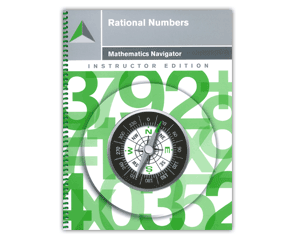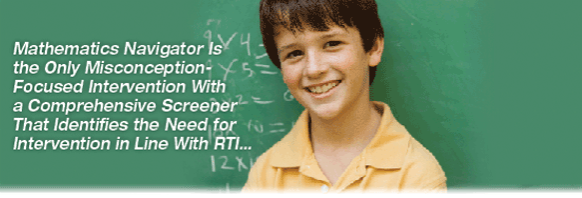Mathematics Navigator™

Mathematics Navigator clearly answers the call for RTI by addressing problems early, before a child falls so far behind that a referral to special education services is warranted.

Teachers need an intervention tool that can quickly and easily diagnose students’ specific needs and shortfalls, recognize faulty learning from earlier grades, and prescribe a focused plan of action to meet these needs and accelerate students’ learning. Mathematics Navigator is not geared toward a quick fix that will get a child through his or her grade. It repairs inherent problems retained from earlier learning and helps kids become better students with a deeper understanding of math and vastly improved work habits. This intervention program is designed for elementary and secondary students who are struggling with specific mathematics concepts and skills.
Mathematics Navigator is designed to target the misconceptions about math that students may have learned in earlier grades. To ensure that students get where they need to be academically, continue learning throughout the school year, and keep up with their class in future grades, these basic misconceptions have to be identified and corrected. Mathematics Navigator was created to do exactly that, and is recognized as the leader in this area.
Mathematics Navigator’s highly focused system of diagnostic screeners and pretests helps you find the areas where students need to rebuild and/or correct their foundation of learning. The program provides proven routines and rituals that guide students through a specific and predictable course of action that supports their learning, maximizes instructional time, and allows for differentiated instruction. It strikes the right balance between emphasis on skills, problem solving, and concepts–students don’t just solve problems and get answers; they are guided to a better comprehension of mathematical concepts.
Why Implement Mathematics Navigator in Your School or District?
Mathematics Navigator
Typical math intervention programs
Surfaces and repairs misconceptions
Attempts to re-teach material slower and louder–prior knowledge and misconceptions interfere with this process
Uses proven routines and rituals
Teachers are left on their own to create programs
Balances skills, problem solving, and concepts
Cluttered and incoherent, relies too much on procedures rather than facilitating real learning
Integrates and engages academic language of math
Math vocabulary is covered but is not used consistently
Teaches students how to develop deep conceptual understanding
Teaches students to get answers without learning math
Teaches personal and social skills so that students can become good math students
Reinforces bad learning habits; students work in isolation to get answers and quit without learning or applying what they have learned to new situations


